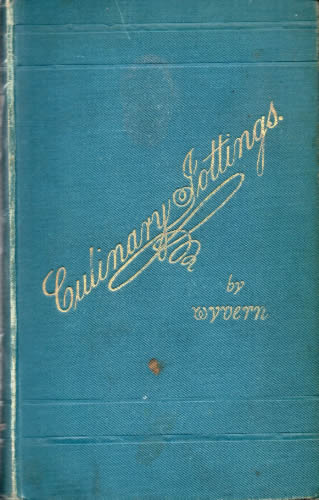Colonel Arthur Robert Kenney-Herbert’s clear mulligatunny.
Under the pseudonym ‘Wyvern,’ the colonel describes both clear and thick mulligatawnys, (he spells it ‘mulligatunny’) in Culinary Jottings for Madras. He considers both variations “really excellent” but believes that from “an artistic point of view” the clear soup is “infinitely the better of the two.” (Jottings 320, 321) The Editor is unwilling to take sides but has devout respect for the colonel and so describes his preference.
 1 quart of any clear consommé or stock
1 quart of any clear consommé or stock- 2 teaspoons coriander seed
- 1 teaspoon cumin seed
- 4-5 curry leaves (optional; see the Notes)
- 1 teaspoon fenugreek
- 2 whole peeled cloves garlic
- ½ half teaspoon mustard seed
- 12 black peppercorns
- hot sauce
- Tie the dry ingredients in cheesecloth or, as the colonel advises, “a muslin bag” and drop the assembly into the stock.
- Boil the soup “until the flavour is satisfactory,” so you get to taste your soup at enticing intervals.
- Throw the seasonings away and add as much hot sauce as you like.
Notes:
-If you cannot find curry leaves, substitute kaffir lime leaves, but if you cannot find curry leaves you probably cannot find kaffir lime either. In that case resort to a bay leaf or two, or dispense with the troublesome leaves altogether.
-If you lack the time or inclination to simmer stock, Campbell’s beef consommé (not the straight stock) will fool a lot of diners.
-It is, as the colonel warns, essential not to resort to anything whatsoever in pounded or bruised let alone powdered form to season the soup. They will produce a cloudy one that will neither look nor taste as good. That is why the colonel relies on hot sauce instead of his more customary cayenne:
“The object in a clear mulligatunny is to present a bright, sparkling consommé of the colour of clear turtle, with a decided flavour of mulligatunny, and slightly peppery…. The pepperiness is best imparted with a few drops of Tabasco as a finishing touch, or of chilli-vinegar if Tabasco is unavailable.” (Jottings 324)
-The colonel’s recipe starts with three imperial pints of consommé or stock and then uses the Editor’s proportions of spice, or ‘condiments’ as he calls them, measured by weight in ounces.
-Nothing here is written in granite. The colonel understands that “as tastes vary in the matter of condiments, they are obviously susceptible of alteration at discretion.” (Jottings 324) Go ahead and change proportions and even the spice but remember not to select something that will cloud the soup to kill its sparkle. But be forewarned; the colonel is a reliably outstanding arbiter of culinary taste.
-In this and in many things, the colonel was striking in his flexibility and emphasis on simplicity, good ingredients and unfussy technique. Any stock will do, although a departure from meat or poultry requires some adjustment to the pristine base recipe. Fish and shellfish stock can anchor a good mulligatawny; so can something vegetarian.
-The colonel provides alternative combinations of vegetables. Nearly anything, but not everything, goes. “Be careful in using turnips. Unless they are very young they are apt to be overstrongly flavoured in this country.” (Jottings 325) In this country too. Any “water in which certain vegetables have been boiled” can stand in for the consommé or stock for clear vegetarian mulligatawny; the colonel suggests carrots, flageolets, French beans, leeks, onions and peas alone or in combination, but the more the merrier enlivened with his standard composition of condiments. He is particularly partial to leeks. (Jottings 326)
-It is hard to envision many of his contemporaries explaining with patience the way to build an alternative, thick mulligatawny from “a stock composed of vegetables,” although his recommendation to use “clarified beef suet” as an alternative to butter in cooking the vegetables sounds a discordant note to the Editor’s ears; perhaps vegetarians in Edwardian India were less doctrinaire.
-Anyway the thickened vegetarian variant, “artfully flavoured with a good mulligatunny paste,” or commercial curry paste, “thickened with flour and butter, and enriched with laite d’amandes, cocoanut milk, cream, or raw yolks of eggs, will be found to make a most excellent soupe maigre.
-The colonel does not add salt to any of these soups on the tacit assumption that the underlying stocks include it.
-The colonel likes rice with a rich, thick mulligatawny but never eats rice with his sparkling paragon. He does, however, concede that [m]acaroni or vermicelli may be added to the clear vegetarian mulligatawny” along with “a dash of white wine” and “grated parmesan may accompany it.” (Jottings 325)
-All references are to the sixth, 1891, edition of Culinary Jottings printed at both Bombay and Calcutta, as they then were known.

